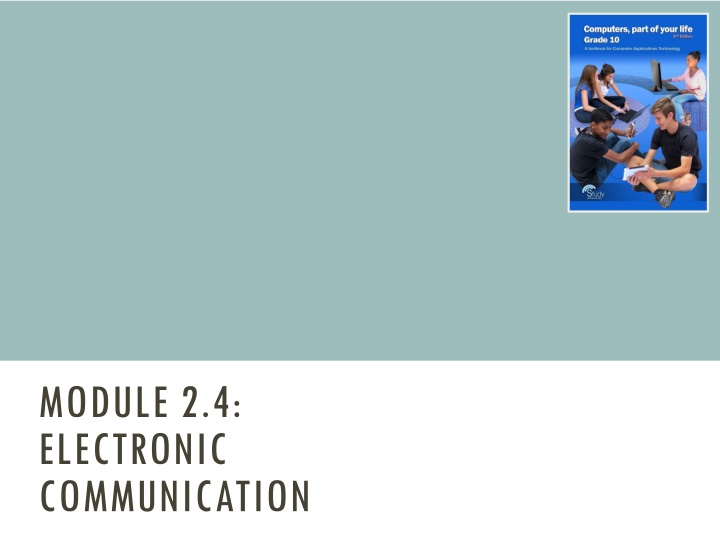
Electronic Communication Essentials
Explore the world of electronic communication in this module covering email, netiquette, practical email use, and more. Learn about different types of email, address organization, and netiquette guidelines for online interactions. Enhance your e-communication skills with practical activities and tests.
Download Presentation

Please find below an Image/Link to download the presentation.
The content on the website is provided AS IS for your information and personal use only. It may not be sold, licensed, or shared on other websites without obtaining consent from the author. If you encounter any issues during the download, it is possible that the publisher has removed the file from their server.
You are allowed to download the files provided on this website for personal or commercial use, subject to the condition that they are used lawfully. All files are the property of their respective owners.
The content on the website is provided AS IS for your information and personal use only. It may not be sold, licensed, or shared on other websites without obtaining consent from the author.
E N D
Presentation Transcript
MODULE 2.4: ELECTRONIC COMMUNICATION
CONTENTS Introduction Activity 2 Email ISP email vs web-based email Email addresses Address book or contacts list Practical use of email Netiquette Netiquette and social networking Netiquette and email Activity 3 Test and improve Activity 1 Written module activity Other modes of e-communication Social networking sites Instant Messaging and Chat applications Weblog (blog) Fax to email 2
INTRODUCTION E-communication all forms of electronic communication Process by which computers and other communication devices are used to exchange messages and/or digital data 3
EMAIL Composing, sending and receiving of messages electronically over a network such as the internet Use email software to type in recipient s address Message first goes to email server at own ISP Message then goes to email server at other person s ISP Message is held there until recipient downloads it 4
EMAIL ISP email vs web-based email Web-based email ISP-based email Accessed using a web browser anywhere where internet access Must be online to access account Free of charge (might pay for internet access) Set up on local computer or device using appropriate software Can be accessed without being online Monthly ISP charge plus internet access cost 5
EMAIL Email addresses Mary.Jones @ mweb.co .za Domain UserName @Service provider .Type of organisation .Geographical location 6
EMAIL Address book or contacts list Used to store email addresses Email addresses added to list manually or automatically, or imported from another application or email system Other information can be added (e.g. phone numbers) Mailing list list of email addresses grouped under a single name 7
EMAIL Practical use of email: Sending, reading, replying and forwarding messages Sending a message Click on COMPOSE to create message To field Cc and Bcc fields Subject field Message area Click on Send to send message 8
EMAIL Practical use of email: Sending, reading, replying and forwarding messages Reading a message Go to Inbox and double-click on message Unread messages are displayed in bold 9
EMAIL Practical use of email: Sending, reading, replying and forwarding messages Replying to a message With message open click on Reply button To field automatically filled in RE: automatically added to Subject Field Reply All sends reply to all addresses in To and Cc fields Original message visible type your reply above it Good practice to leave original message allows recipient to keep track of correspondence 10
EMAIL Practical use of email: Sending, reading, replying and forwarding messages Forwarding a message Do not forward chain letters or hoaxes Click on Forward button FW: automatically added to Subject field Good practice to delete unnecessary addresses of people who have received the message, before you forward it 11
EMAIL Practical use of email: Attachments Email applications let you attach files to messages Program files with extension .exe sometimes not allowed because of virus risks Limit on size of attachments (Gmail 25 MB) Acceptable max size differs from organization to organization 12
EMAIL Practical use of email: Attachments To attach a file: Click Attachicon A dialog box will appear Locate the file, click Open to attach Click Send 13
EMAIL Practical use of email: Attachments To open attachment: First open message attachment shown as icon with name of file Save file to computer, then open file (Can open file without saving it first file will open in application associated with that type of file) Do not open attachments in messages from people you do not trust might contain a virus 14
ACTIVITY 1 15
OTHER MODES OF E-COMMUNICATION Social networking sites Interactive websites where individuals and organisations post their likes, dislikes, photographs and activities for friends and interested parties to read and respond to 16
OTHER MODES OF E-COMMUNICATION Instant Messaging and Chat applications These applications occur in real time (different to email) Many social networking sites offer instant messaging 17
OTHER MODES OF E-COMMUNICATION Weblog (blog) Website updated regularly with news and events Reads like a journal with most recent entry at the top Not just personal also used by businesses, citizen journalists, etc. 18
OTHER MODES OF E-COMMUNICATION Fax to email Ability to send/receive fax to/from a fax machine using computer and email system Register with service provider that offers this service will receive dedicated fax number Free for incoming faxes, pay for faxes you send 19
ACTIVITY 2 20
NETIQUETTE Netiquette and social networking Use of good manners and showing respect for other users when using the internet Think before you post Would I be happy if this were placed on a public poster? Would I be happy for e.g. my parents or teacher to see this? Is this the kind of information that reflects who I am? Would I be happy for a prospective employer to see my site? 21
NETIQUETTE Netiquette and email Message must be clear and error-free Never type messages only in capital letters Files attached to a message must be viruses-free Never be insulting in a message If you wish to tease someone, use an emoticon or emoji to show you are just teasing ;-) 22
NETIQUETTE Netiquette and email Use emoticons and emojis only in informal correspondence Never pass on chain mail, hoaxes or spam Large attachments first contact recipient and agree on a suitable method Be careful of passing on personal information via email 23
ACTIVITY 3 24
TEST AND IMPROVE Summary concepts, terms and tips Other modes of electronic communication Email Netiquette ISP-based Web-based Format of email address Address book or contacts list Mailing list Practical tips Social networking sites Instant messaging, chat, SMS Weblog (blog) Fax to email Social networking sites Email 25

